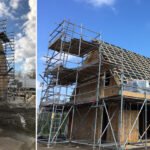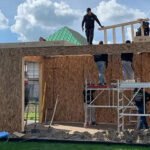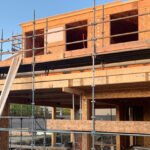
From Factory to Jobsite: Behind the Scenes at Quacent
Most people see only the finished building—modern, efficient, and comfortable. What they don’t see is the journey that begins long before the first wall goes up on site. At Quacent, every home, school, or resort unit built with Structural Insulated Panels (SIPs) starts its life in our factory.
This blog takes you behind the scenes to reveal how SIPs are made, packaged, and delivered from the factory floor to the construction site. By understanding this process, you’ll see why Quacent’s Ready-To-Assemble (RTA) SIP kits make building faster, more sustainable, and more reliable.
Step 1: Raw Materials and Quality Control
The process begins with carefully selected raw materials:
- OSB4 Facings: Engineered structural boards that provide strength and durability.
- Neopor® Core: High-performance insulation that delivers superior thermal values.
- Adhesives: Specialized bonding agents ensure long-term panel integrity.
Before production begins, all incoming materials are checked against strict quality standards. Moisture content in OSB is monitored, insulation density is tested, and adhesives are stored under controlled conditions. This ensures that every panel meets the high-performance benchmarks required by European building standards.
Step 2: Panel Lamination
At the heart of SIP production is the lamination process. OSB facings and Neopor® insulation are bonded under pressure using industrial presses.
- Uniform Pressure guarantees strong adhesion across the entire panel.
- Computer Monitoring tracks curing times and adhesive distribution.
- Batch Testing ensures that each production run meets structural and thermal performance requirements.
This is where SIPs gain their unique combination of structural strength and energy efficiency.
Step 3: CNC Cutting and Detailing
Once laminated, the large SIP boards move to CNC (computer numerical control) machines. Here, precision cutting brings the project’s design to life:
- Openings for windows and doors are cut to exact dimensions.
- Channels for electrical conduits are integrated directly into the panels.
- Edge detailing ensures tight, airtight joints during assembly.
CNC precision means that what is designed in BIM software is exactly what arrives on site. This eliminates costly adjustments and ensures predictable timelines.
Step 4: Packaging as RTA Kits
Quacent’s hallmark is the Ready-To-Assemble (RTA) approach. Once cut, panels are organized and packaged by construction phase:
- Phase 1: Ground floor walls.
- Phase 2: Upper floors and walls.
- Phase 3: Roof panels.
Each package includes all necessary fasteners, splines, and connectors. Clear labeling ensures contractors can easily identify which panel goes where. This systematic approach keeps construction sites organized and prevents delays.
Step 5: Logistics and Shipping
Efficient logistics are critical to making prefab work. SIPs are stacked flat and loaded into containers for transport by ship, truck, or both.
- Containerized Shipping reduces costs and protects panels during transit.
- Just-in-Time Delivery ensures panels arrive on site exactly when needed, reducing the need for storage space.
- Customs and Compliance: For international projects, all documents and certifications are prepared in advance, ensuring smooth border crossings.
By the time the trailer arrives at the jobsite, everything is ready for immediate assembly.
Step 6: On-Site Assembly
The final step is where factory precision meets construction reality. With foundations prepared, the SIP kits are unloaded and assembled like a giant puzzle.
- Small Crews: Typically, a team of 4–6 workers can erect an entire SIP home.
- Rapid Progress: Within a week, the shell is weather-tight.
- Supervision: Quacent often provides on-site supervisors or training sessions for first-time SIP builders.
Because the panels are pre-cut and packaged by sequence, the construction process is intuitive, fast, and error-free.
Why This Process Matters
Taking a behind-the-scenes look highlights why Quacent SIPs stand out:
- Reliability: Factory-controlled production reduces on-site surprises.
- Speed: CNC precision and RTA packaging streamline assembly.
- Sustainability: Waste is minimized at every stage, from raw material selection to transport.
- Scalability: The same process can be applied to a single family home or a multi-unit development.
By moving complexity into the factory, Quacent makes construction on site simpler, faster, and more predictable.
Lessons for the Industry
The success of Quacent’s factory-to-jobsite process offers lessons for the broader industry:
- Integration Is Key: From design to delivery, every stage must be digitally connected.
- Packaging Matters: Organizing materials by phase reduces confusion on site.
- Partnerships Enhance Results: Combining factory expertise with local contractor knowledge ensures success.
- Transparency Builds Trust: By showing clients exactly how panels are made and delivered, Quacent strengthens confidence in the product.
Conclusion
Behind every Quacent SIP project lies a process designed for speed, precision, and sustainability. From raw materials to lamination, CNC cutting, packaging, and shipping, each step is carefully controlled to ensure that what arrives on site is ready to assemble with minimal effort.
For developers and contractors, this behind-the-scenes process explains why Quacent SIPs consistently deliver faster builds, higher performance, and more sustainable results. For homeowners, it means confidence that their property was built on a foundation of precision and quality.
Quacent is not just producing panels—we are redefining how buildings are designed, shipped, and assembled in Europe and beyond.





Add a comment